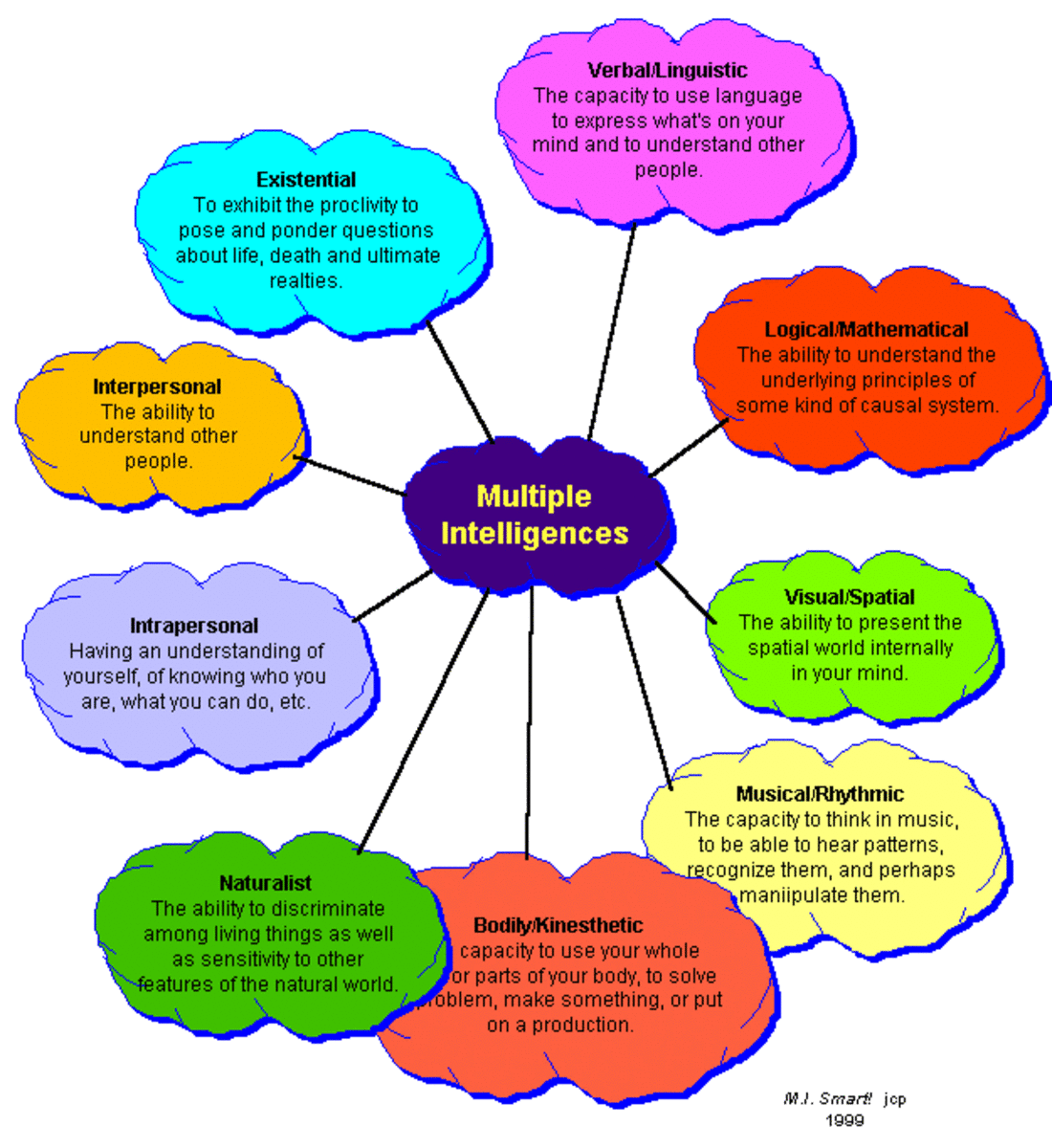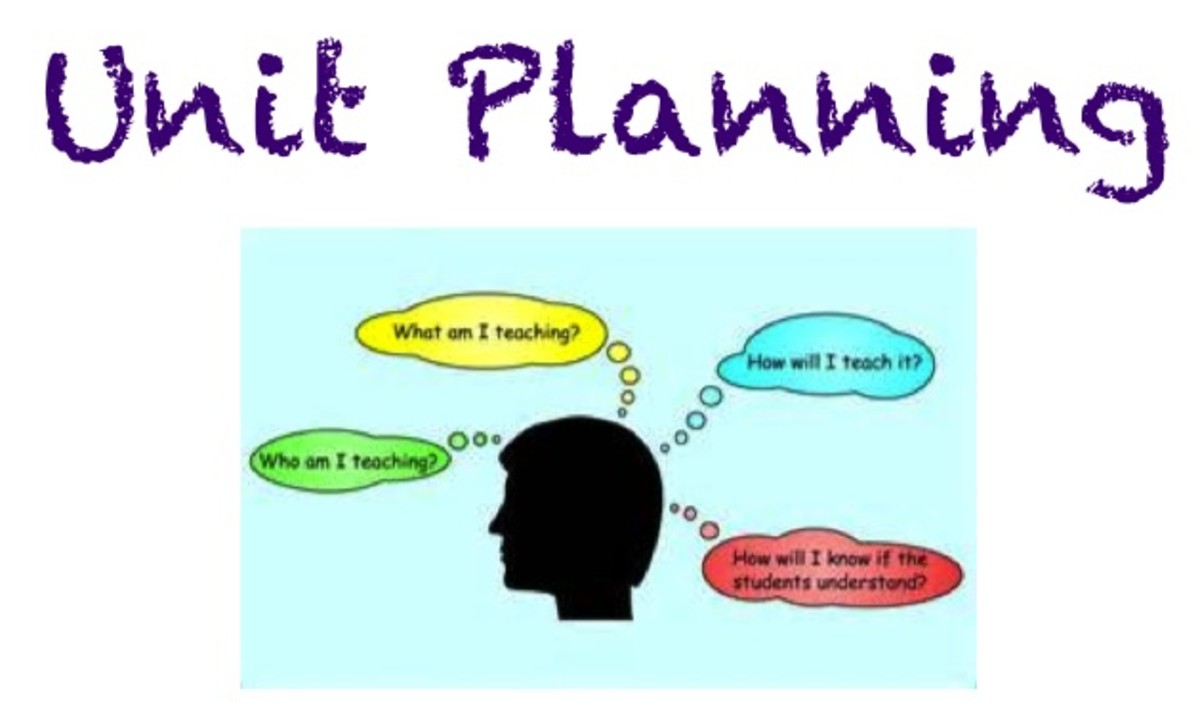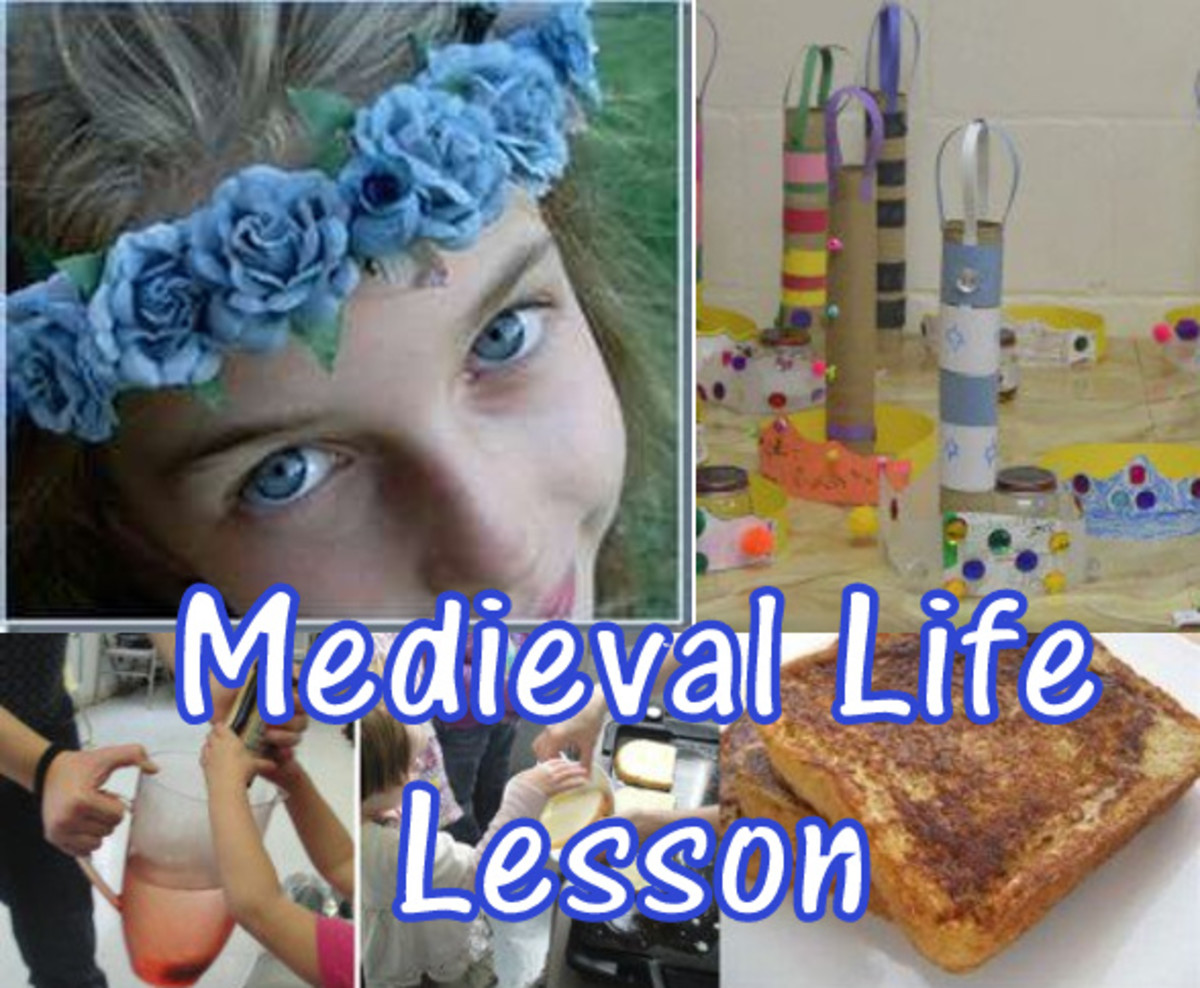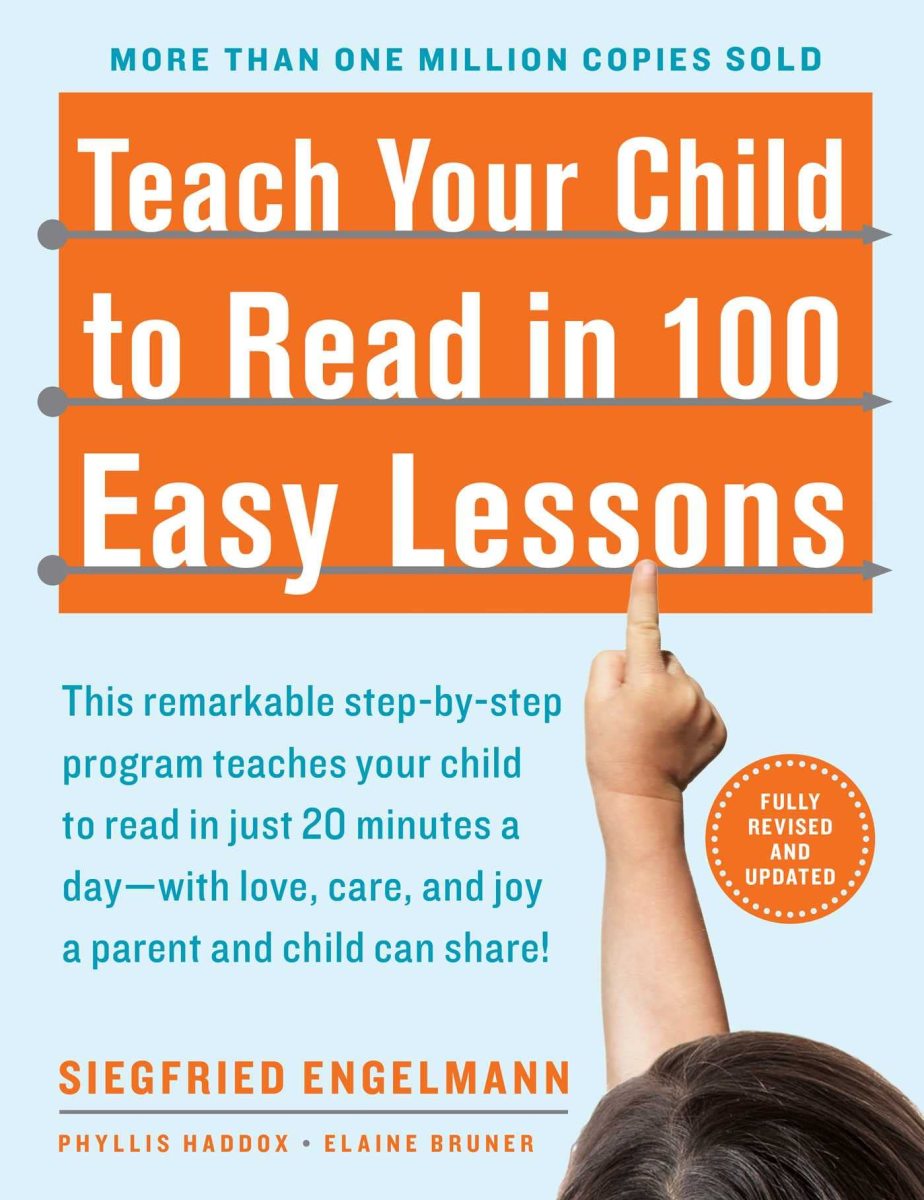Gardner's Multiple Intelligence Theory
Learning Experiences

Multiple Intelligence
by Eric Specht
Traditional or Modern Principles
Fundamental teaching practices are just that, educating basic knowledge to the youth. However, individual learning capabilities differ from one another, so traditional teaching methods may limit broadening a student’s aptitude. Modernizing current teaching practices by incorporating Gardner’s theory in school curriculum helps discover which of the multiple intelligences an individual excels at to obtain knowledge. Furthermore, adopting the MI Theory in classrooms assists strengthen an individual’s lesser quality learning abilities by concentrating on specific regions of the brain (Dickinson, 2010). Clearly aware that students excel academically in one educational aspect than another, educators quickly adopt Gardner’s theory. Thinking outside of the traditional teaching practices of reading, writing, and arithmetic, schoolteachers implement techniques designed around the MI Theory to enhance their student’s overall performance.
Gardner’s Multiple Intelligence Theory
Quality or Quantity
To best familiarize with Gardner’s Multiple Intelligence Theory it will be necessary to make contrasts between the time-honored intelligence with Gardner’s declaration. The intelligence that we are accustomed to suggests the quality of our overall performance. For instance, an individual’s scholarly average or IQ is determined through knowledge obtained from a variety of school curricula, thus results his or her mental power (Gardner, 2002). On the other hand, Gardner speculates the brain is composed of additional intelligences, most of which not yet been considered to measure ones full potential. Secondly, customary intelligence perceives to be a single quality composed from a compilation of knowledge, whereas Gardner stipulates the collection of knowledge derive from separate intelligences. For example, a student who excels at mathematics, known as Gardner’s logical/mathematical intelligence, but academically struggles to pass English class, Gardner’s linguistic intelligence, indicates a conflict between two different schemes. As a result, educators who acknowledge their student’s different subject grades can identify with multiple intelligences and may subsequently begin to step out of standard teaching techniques.
Howard Gardner
What's Your Intelligence?
Multiple Intelligence Theory
MI Modules
When there were seven multiple intelligences, Bruce Campbell, a schoolteacher and a commendable author, developed one program per proposed intelligence to educate his pupils on the subject at hand. For instance, if the curriculum asked to educate the pupils on a historical event, such as the Civil War, he would design seven different teaching modules. He may have chosen a program for his students to reenact a Civil War battle, which would aid his students by learning through bodily/kinesthetic intelligence, or acquiring knowledge through physical experience. Perhaps a module for the artistic students or for those who possess a higher intellect in the visual/spatial intelligence, would gain more knowledge by creating Civil War replicas, differentiating the northern states from the southern states. Campbell arranged his students into small groups that attended each intelligence station for about twenty minutes, merely expending two and a half hours out of each school day session (Campbell, 1995).
Influencing Educators
After examining multiple intelligence literatures and attending Gardner’s lectures, Nelly Ribot, educating English as a second language, decided she too would incorporate the MI Theory into her schools educational syllabus. Collaborating with her supportive and enthusiastic colleagues, she developed multiple intelligence methods pertained to “Helpers”, which was the theme in learning occupational English words (Ribot, 2004). She integrated the Naturalistic Intelligence, defined as intense examination and classification of plants, animals and objects, into her teachings through a field trip. This allowed her students to identify occupational structures and make a correspondence to the English word. She also applied the Musical Intelligence by creating instruments with her students and then used them to produce music to sing songs about professional’s and their careers. Nelly Ribot also created modules that introduced each intellect, which enabled her students to obtain and sustain their English language learningdevelopments.
Intra and Interpersonal Growth
In addition to designing curricula modules concentrated on specific intelligences, multiple intelligence practices enhance an individual’s independent and social skills, otherwise not directly taught as a classroom subject. Interpersonal intelligence is the social knack to engage morally within the diverse public realm. As a result, individuals will be able to communicate, understand, and collaborate efficiently with others. On the other side of the coin is Intrapersonal intelligence, which is the ability to control one’s own thoughts and emotions consciously. An example of an individual with a high aptitude in independent intelligence is one with autism. Although autistic individuals are impaired to its comprehension and lack quality in other intelligences to capitalize on their talent, they are autonomous in absorbing information pertaining to the gift they obtain (Klien, 1997). Even though the two intelligences are indirect teaching schemes in traditional school curricula, schoolteachers deem them, through Garner’s intellect, as valuable traits to directly acknowledge and broaden, so students may achieve success throughout life’s journey.
MI Tested
However, participant appraisals alone do not solidify as concrete evidence to convey MI Theory as scientific evidence; therefore, a three-year study was executed by Mindy Kornhaber a Penn State Assistant Professor of educational Policy and Theory. Her report concludes evidence verifying why schoolteachers chose and continue to adopt the MI Theory into their classrooms. The research obtained to retrieve results on Gardner’s Multiple Intelligence Theory stretched across thirteen states, which included thirty-nine public schools and two private schools. Kornhaber reported that forty-nine percent of students improved on their test scores, fifty-four percent lessened their behavioral problems, an increased sixty percent pertained to parents participation with the students, and a ninety-eight percent improvement for students with learningdisabilities (“Multiple Intelligence Theory, 2003). Not only does this study nudge Gardner’s presumption towards scientific consent, it raises educator’s eyebrows with the consideration of modernizing general teaching exercises by implementing multiple intelligence practices.
Flexible Modules
The acceptance of the Multiple Intelligence Theory, based upon professional schoolteachers and the passion they bring to the table, assists their student’s intellectual developments. A schoolteacher’s job description is to teach a state mandated curriculum, but instead of portraying themselves as an authority figure, they step out of the tradition routine teaching methods to become a student friendly facilitator. An educator continuously seeks for amended systems that will be effectively efficient in providing their students with knowledge that they may take with them throughout their life. The passions they possess initiate the motivation to be a quality benefactor; therefore, teachers adopt and design schemes around the MI Theory. Furthermore, Gardner’s theory assists teachers with their curricula designs. First, practicing the theory creates more exposure to knowledge within the subject by maintaining the student’s attentiveness. Secondly, it reveals students naturally gifted and impaired talents that aid teachers to develop personal and diverse instructions. The theory also enables teachers to help students make cognitive technique correlations with each of their multiple intelligences, which broadens a student’s critical thinking process (Wilson, 1998).
Performance or Detour
There are many lures depicted by professionals that attract other educators nationally to empower the minds of their students, however, educators who are not willing to learn a new teaching system, refuse to break traditional habits, and wait for scientific acclamation may disrupt mandating Gardner’s Multiple Intelligence Theory in school structures. Although, for those you have voluntarily practiced the Multiple Intelligence Theory proved its value by dismembering writing utensils from cramped hands, regained attentiveness fallen to repetitious exercises, exposed moral behaviors freed from the isolation of a desk, and sharpened each of an individual’s multiple intellect. Gardner’s Multiple Intelligence Theory along with the inventive schematics, produced by schoolteachers willing to lose their reputation, heighten a student’s overall functions beyond traditional curricula learning’s, which ultimately may lead to new curricula designs or a scientific road block with few daring detours.
Ken Robinson
Reference List
Campbell, B. (1989). Muliplying Intelligences in the Classroom. In JohnHopkins
Univerity School of Education [Articles]. Retrieved May 31, 2010, from New Horizons for Learning website: http://education.jhu.edu/newhorizons/strategies/topics/mi/
Teacher/Author develops a program to teach the intelligences.Dickinson, D. (2010). Learning Through Many Kinds of Intelligences. In John Hopkins University School of Education . Retrieved June 13, 2010, fromhttp://education.jhu.edu/newhorizons/strategies/topics/mi/dickinson_mi.html
Gardner, H. (2002). Seven Steps to Multiple Intelligences. In John Hokins
niversity School of Education (multiple intelligences). Retrieved June 13, 2010, fromhttp://education.jhu.edu/newhorizons/future/Creating_the_Future/crfut_gardner.cfm
Compiled and Edited by Dee, Dickinson, Klien, P. (1997, Fall). Multiplying the problems of intelligence by eight: a critique of Gardner's theory . In ProQuest (empirical problems exceptional populations) [Journal]. Retrieved May 31, 2010, from Proquest database. (Document ID: 391336691)
Multiple Intelligences. (2010). John Hopkins University School of Education .
Retrieved June 13, 2010, from JohnHopkinsUniversitywebsite:http://education.jhu.edu/newhorizons/strategies/topics/mi/
Multiple intelligences theory, multiple improvements. (2003, September). ProQuest[Periodical]. Retrieved June 18, 2010, from Proquest database. (Document ID: 415276421)
Ribot, N. (2004, March). My Experiences using the Multiple Intelligences. In
John Hopkins Univerity School of Education [Articles]. Retrieved May 31, 2010, fromhttp://education.jhu.edu/newhorizons/strategies/topics/mi/
Teacher uses MI theory in her English class. Wilson, L.O.(1998, March). Why teachers are drawn to using Multiple
Intelligences Theory in their classrooms. In John Hopkins University School of Education [Article]. Retrieved June 19, 2010.
Winner, E. (2010). Bio: written by EllenWinner. In Howard Gardner (biography). Retrieved June 5, 2010, from http://www.howardgardner.com/









